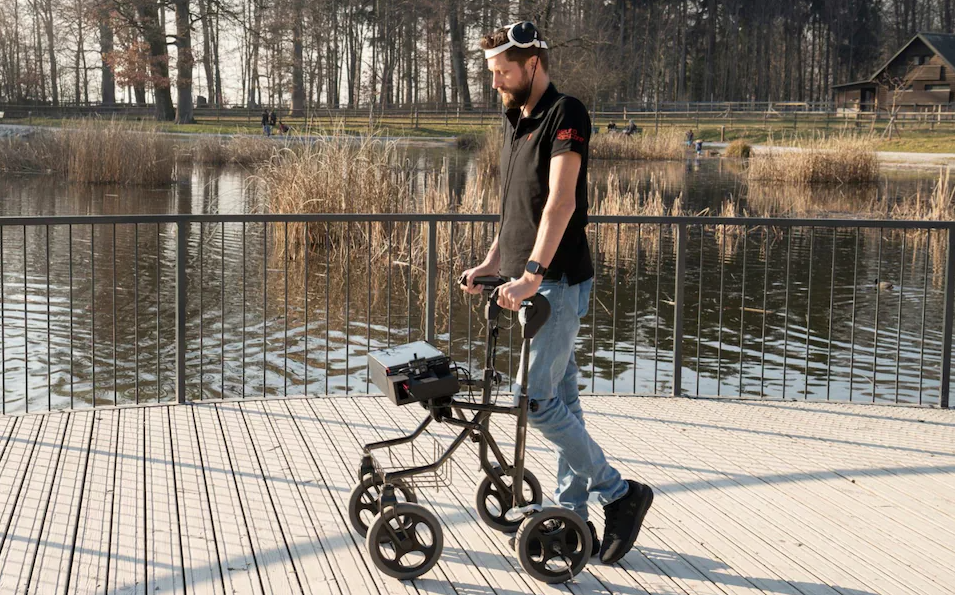
©Ecole Polytechnique Federale de Lausanne via telegraph.co.uk
Vocabulary:
I will read the words, meanings, and sample sentences. Then, repeat after me.
- initiate /ih-NISH-ee-eyt/
- trigger /TRIG-er/
- portable /PAWR-tuh-buhl/
- deficit /DEF-uh-sit/
- disorder /dis-AWR-der/
[verb] – to cause something to begin
The government initiated a program to provide financial assistance to small businesses.
[noun] – a device, as a lever, the pulling or pressing of which releases a catch or spring
The trigger of the camera allowed her to capture the perfect moment.
[adjective] – light and small enough to be easily carried or moved
The portable speaker is lightweight and easy to carry around for outdoor parties.
[noun] – a disadvantage, impairment, or handicap
His hearing deficit made it challenging for him to follow conversations in noisy environments.
[noun] – an illness of the mind or body
The patient’s uncontrolled shaking and muscle stiffness are signs of Parkinson’s disease, a neurological disorder.
Article reading:
Please read the whole article. Then, I will check your pronunciation and intonation.
A revolutionary medical device has enabled a paralyzed man to regain his natural walking ability after more than ten years. The Swiss Federal Institute of Technology developed a “brain-spine interface,” connecting the brain and spinal cord through implants. These brain implants track movement intentions, wirelessly transmitting them to an external processing unit worn by the patient. The intentions are then translated into commands and sent back via a second implant to stimulate the muscles. Gert-Jan Oskam, 40, had been paralyzed in a motorbike accident in China over a decade ago, affecting his legs, arms, and trunk. Oskam expressed his wish to walk again and believed it was possible with the device. He can now walk distances of at least 100 meters and stand unassisted for a few minutes.
Unlike previous stimulation devices, this technology grants Oskam full control over the stimulation, allowing him to initiate movement without external triggers. The device’s ability to provide smoother movements and adapt to varying terrains is due to the reconnection of two central nervous system regions disrupted by the spinal cord injury. The connection established by the implants has remained reliable for over a year, even when Oskam is at home, contributing to his regained strength. The success of this trial has opened up possibilities for future applications, including treating individuals with arm and hand paralysis or those who have suffered a stroke. The researchers aim to make the system more portable by reducing its size. This groundbreaking research heralds a new era in the treatment of motor deficits caused by neurological disorders, presenting the potential for a digital bridge between the brain and spinal cord.
Unlike previous stimulation devices, this technology grants Oskam full control over the stimulation, allowing him to initiate movement without external triggers. The device’s ability to provide smoother movements and adapt to varying terrains is due to the reconnection of two central nervous system regions disrupted by the spinal cord injury. The connection established by the implants has remained reliable for over a year, even when Oskam is at home, contributing to his regained strength. The success of this trial has opened up possibilities for future applications, including treating individuals with arm and hand paralysis or those who have suffered a stroke. The researchers aim to make the system more portable by reducing its size. This groundbreaking research heralds a new era in the treatment of motor deficits caused by neurological disorders, presenting the potential for a digital bridge between the brain and spinal cord.
Discussion Questions:
I will read each question. Then, please answer them.
- The article talks about the medical device that helped a paralyzed man walk again. What do you think about this incredible achievement?
- How do you feel about the potential of this device to create a connection between the brain and spinal cord?
- Do you think this device is a breakthrough for paralyzed people?
- What challenges or limitations might come with using the brain-spine interface device? How do you think researchers can overcome those challenges?
- How do you feel about the potential of this device to create a connection between the brain and spinal cord? Do you think it has the potential to change the lives of many people with similar conditions? In what ways?
Summarization
Please summarize the whole article using your own words and expressions. You will have one minute to prepare before you answer.
Describe:
Please explain the definition of each word listed below based on your understanding. You can provide example sentences if needed.
- groundbreaking
- implant
- interface
- neurological
- paralysis